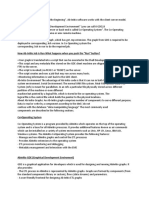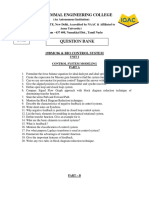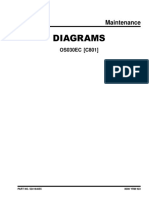Ruby Homework
Ruby Homework
Uploaded by
roopakv1990Copyright:
Available Formats
Ruby Homework
Ruby Homework
Uploaded by
roopakv1990Copyright
Available Formats
Share this document
Did you find this document useful?
Is this content inappropriate?
Copyright:
Available Formats
Ruby Homework
Ruby Homework
Uploaded by
roopakv1990Copyright:
Available Formats
HW 2: more Ruby, and some Rails
In this homework you will clone a GitHub repo containing an existing simple Rails app, add a feature to the app, and deploy the result publicly on the Heroku platform. We will run live integration tests against your deployed version. General advice: This homework involves modifying RottenPotatoes in various ways. Git is your friend: commit frequently in case you inadvertently break something that was working before! That way you can always back up to an earlier revision, or just visually compare what changed in each file since your last "good" commit.
Remember: Commit early and often!
1. open classes, metaprogramming, duck typing
a) [ELLS ex. 3.11] Extend the currency-conversion example from lecture so that you can write 5.dollars.in(:euros) 10.euros.in(:rupees) etc. You should support the currencies 'dollars', 'euros', 'rupees' , 'yen' where the conversions are: rupees to dollars, multiply by 0.019; yen to dollars, multiply by 0.013; euro to dollars, multiply by 1.292. Both the singular and plural forms of each currency should be acceptable, e.g. 1.dollar.in(:rupees) and 10.rupees.in(:euro) should work. You can use the code shown in lecture as a starting point if you wish; it is at http://pastebin.com/ agjb5qBF b) Adapt your solution from HW 1 "palindromes" question so that instead of writing palindrome? ("foo") you can write "foo".palindrome? HINT: this should require fewer than 5 lines of code. c) Adapt your palindrome solution so that it works on Enumerables. That is: [1,2,3,2,1].palindrome? # => true (It's not necessary for the collection's elements to be palindromes themselves--only that the top-level collection be a palindrome.) HINT: this should require fewer than 5 lines of code. Although hashes are considered Enumerables, your solution does not need to make sense for hashes (though it should not error).
2. iterators, blocks, yield
Given two collections (of possibly different lengths), we want to get the Cartesian product of the sequencesin other words, every possible pair of N elements where one element is drawn from each collection. For example, the Cartesian product of the sequences a==[:a,:b,:c] and b==[4,5] is: ab == [[:a,4],[:a,5],[:b,4],[:b,5],[:c,4],[:c,5]]
Create a method that accepts two sequences and returns an iterator that will yield the elements of the Cartesian product, one at a time, as a two-element array. It doesn't matter what order the elements are returned in. So for the above example, the ordering [[:a,4], [:b,4], [:c,4], [:a,5], [:b,5], [:c,5]] would be correct, as would any other ordering. It does matter that within each pair, the order of the elements matches the order in which the original sequences were provided. That is, [:a,4] is a member of the Cartesian product ab, but [4,:a] is not. (Although [4,:a] is a member of the Cartesian product ba.] To start you off, here is a code skeleton and some examples showing possible correct results.
3. deploy & enhance RottenPotatoes
a) Add some movies to RottenPotatoes, and deploy it to the world (sort of)
We have a version of RottenPotatoes that has had some slight modifications for successful deployment on Heroku, and to which we've added a handful more movies to make things interesting. Check it out to your VM by doing: git clone git://github.com/saasbook/hw2_rottenpotatoes.git cd hw2_rottenpotatoes You may have to install gems with bundle install --without production to ignore the PostgreSQL gem for your local installation. Verify that you can successfully run it using rails server and interact with it via a Web browser, as described in the book and in lecture. Note that we provided a migration that adds a bunch more movies to the database. Take a look at the code in db/migrate/ to review how these work. Once the above is working on your development computer, it's time to deploy. (Appendix A in the textbook has more information about this procedure.) Create a free Heroku.com account if you haven't already, and deploy RottenPotatoes there. (Note that your app's name, something.herokuapp.com, must be unique among Heroku apps; therefore it's unlikely that the name "rottenpotatoes" will be available, so you can either choose a different name or just keep the default name Heroku chooses for you whenever you create a new app.) Since this is the first deployment of this app on Heroku, its database will be empty. To fix this, after you've pushed your app to Heroku, run heroku rake db:migrate to apply all RottenPotatoes migrations--the initial one that creates the Movies table (which had already been applied when you got your VM) and the one we provided above that adds more movies. Visit your site at something.herokuapp.com/movies to verify that its working.
b) RottenPotatoes enhancement #1: Sorting the list of all movies.
Enhance RP in the following way:
On the list of all movies page, the column headings for 'title' and 'release date' for a movie should be clickable links. Clicking one of them should cause the list to be reloaded but sorted in ascending order on that column. For example, clicking the 'release date' column heading should redisplay the list of movies with the earliestreleased movies first; clicking the 'title' field should list the movies alphabetically by title. (For movies whose names begin with non-letters, the sort order should match the behavior of String#<=>.) IMPORTANT for grading purposes: The link (that is, the <a> tag) for sorting by title should have the HTML element id title_header. The link for sorting by release date should have the HTML element id release_date_header. The table containing the list of movies should have the HTML element id movies (this has already been set for you by existing code). When the listing page is redisplayed with sorting-on-a-column enabled, the column header that was selected for sorting should appear with a yellow background, as shown below. You should do this by setting controller variables that are used to conditionally set the CSS class of the appropriate table heading to hilite, and pasting this simple CSS into RottenPotatoes' app/assets/stylesheets/application.css file.
Here are some hints and caveats as you do this part: The current RottenPotatoes views use the Rails-provided "resourceful routes" helper movies_path to generate the correct URI for the movies index page. You may find it helpful to know that if you pass this helper method a hash of additional parameters, those parameters will be parsed by Rails and available in the params[] hash. Databases are pretty good at returning collections of rows in sorted order according to one or more attributes. Before you rush to sort the collection returned from the database, look at the documentation for the ActiveRecord find and all methods and see if you can get the database to do the work for you. Don't put code in your views! The view shouldn't have to sort the collection itselfits job is just to show stuff. The controller should spoon-feed the view exactly what is to be displayed.
4. RottenPotatoes enhancement #2: filter the list of movies
Enhance RottenPotatoes as follows. At the top of the All Movies listing, add some checkboxes that allow the user to filter the list to show only movies with certain MPAA ratings:
When the Refresh button is pressed, the list of movies is redisplayed showing only those movies whose ratings were checked. This will require a couple of pieces of code. We have provided the code that generates the checkboxes form, which you can include in the index.html.haml template, here on Pastebin. BUT, you have to do a bit of work to use it: our code expects the variable @all_ratings to be an enumerable collection of all possible values of a movie rating, such as ['G','PG','PG13','R']. The controller method needs to set up this variable. And since the possible values of movie ratings are really the responsibility of the Movie model, it's best if the controller sets this variable by consulting the Model. Create a class method of Movie that returns an appropriate value for this collection. You will also need code that figures out (i) how to figure out which boxes the user checked and (ii) how to restrict the database query based on that result. Regarding (i), try viewing the source of the movie listings with the checkbox form, and you'll see that the checkboxes have field names like ratings[G], ratings[PG], etc. This trick will cause Rails to aggregate the values into a single hash called ratings, whose keys will be the names of the checked boxes only and whose values will be the value attribute of the checkbox (which is "1" by default, since we didn't specify another value when calling the check_box_tag helper). That is, if the user checks the 'G' and 'R' boxes, params will include as one if its values :ratings=>{"G"=>"1", "R"=>"1"} . Check out the Hash documentation for an easy way to grab just the keys of a hash, since we don't care about the values in this case. Regarding (ii), you'll probably end up replacing Movie.all with Movie.find, which has various options to help you restrict the database query. Two caveats: Make sure that you don't break the sorted-column functionality you added in part 3b! That is, sorting by column headers should still work, and if the user then clicks
the "Movie Title" column header to sort by movie title, the displayed results should both be sorted and be limited by the Ratings checkboxes.
If the user checks (say) 'G' and 'PG' and then redisplays the list, the checkboxes that were used to filter the output should appear checked when the list is redisplayed. This will require you to modify the checkbox form slightly from the version we provided above. Don't put code in your views! Set up some kind of instance variable in the controller that remembers which ratings were actually used to do the filtering, and make that variable available to the view so that the appropriate boxes can be pre-checked when the index view is reloaded. Update: Make sure that your form elements have the following ids. The submit button for filtering by ratings should have an HTML element id of ratings_submit. Each checkbox should have an HTML element id of ratings_#{rating}, where the interpolated rating should be the rating itself, such as PG-13, G. An example of an id for the checkbox for PG-13 is ratings_PG-13.
5. RottenPotatoes enhancement #3: remember the settings
OK, so the user can now click on the Title or Release Date headings and see movies sorted by those columns, and can additionally use the checkboxes to restrict the listing to movies with certain ratings only. And we have preserved RESTfulness, because the URI itself always contains the parameters that will control sorting and filtering. The last step is to remember these settings. That is, if the user has selected any combination of column sorting and restrict-by-rating constraints, and then the user clicks to see the details of one of the movies (for example), when she clicks the Back to Movie List on the detail page, the movie listing should "remember" the user's sorting and filtering settings from before. (Clicking away from the list to see the details of a movie is only one example; the settings should be remembered regardless what actions the user takes, so that any time she visits the index page, the settings are correctly reinstated.) The best way to do the "remembering" will be to use the session[] hash. The session is like the flash[], except that once you set something in the session[] it is remembered "forever" until you nuke the session with session.clear or selectively delete things from it with session.delete(:some_key). That way, in the index method, you can selectively apply the settings from the session[] even if the incoming URI doesn't have the appropriate params[] set. However, there are two caveats! If the user explicitly includes new sorting/filtering settings in params[], the session should not override them. On the contrary, the new settings should be remembered in the session. To be RESTful, we want to preserve the property that a URI that results in a sorted/ filtered view always contains the corresponding sorting/filtering parameters. Therefore, if you find that the incoming URI is lacking the right params[] and you're forced to fill them in from the session[], the RESTful thing to do is to redirect_to the new URI containing the appropriate parameters.
DON'T FORGET TO DEPLOY: Deploying your finished app to Heroku by the homework deadline is part of the grading process. Even if you have code checked in that works properly, you still need to also deploy it to Heroku to get full credit.
You might also like
- Tutorialspoint For R PDFDocument34 pagesTutorialspoint For R PDFPratishtha94100% (2)
- Step by Step Tutorials in Bapi-SAP ABAPDocument116 pagesStep by Step Tutorials in Bapi-SAP ABAPNelson GarciaNo ratings yet
- ABInitio FAQDocument20 pagesABInitio FAQVankayalapati SrikanthNo ratings yet
- Berklee Guitar Scale FingeringDocument7 pagesBerklee Guitar Scale FingeringGianfranco ChighineNo ratings yet
- HW2 AThorough GuideDocument6 pagesHW2 AThorough GuideJoão Marcos MeloNo ratings yet
- hw4Document4 pageshw4justin.muchunuNo ratings yet
- Web Scrapping On RDocument6 pagesWeb Scrapping On RAna Mayorca AlzateNo ratings yet
- Me Project Sorting VisualiserDocument10 pagesMe Project Sorting VisualiserArpit PandeyNo ratings yet
- Test Za FirmuDocument2 pagesTest Za FirmuKatarina VuletaNo ratings yet
- Java-Assignment 2 PDFDocument4 pagesJava-Assignment 2 PDFMayur IngleNo ratings yet
- RTutorial MKDDocument16 pagesRTutorial MKDCeline HalabiNo ratings yet
- RTutorial MKDDocument16 pagesRTutorial MKDCeline HalabiNo ratings yet
- Using The Shiny Package in R by Mapping "The Amazing Race"Document15 pagesUsing The Shiny Package in R by Mapping "The Amazing Race"Jon FivelsdalNo ratings yet
- Assignment For Module #3: Recipe Finder: Functional RequirementsDocument6 pagesAssignment For Module #3: Recipe Finder: Functional RequirementsAreej EhsanNo ratings yet
- Project #1 - Buffer Pool - CMU 15-445 - 645 - Intro To Database SystemsDocument1 pageProject #1 - Buffer Pool - CMU 15-445 - 645 - Intro To Database SystemsalucardchaNo ratings yet
- 44 Defining A Zero Downtime DeploymentDocument5 pages44 Defining A Zero Downtime DeploymentAjay SinghNo ratings yet
- ReaClassical User Guide PDFDocument23 pagesReaClassical User Guide PDFItalian Sax Week www.italiansaxweek.itNo ratings yet
- Lecture11 HandoutDocument6 pagesLecture11 HandoutGuadalupe KingNo ratings yet
- Project 2: Exploring The Github Dataset With Colaboratory: CollaboratorsDocument17 pagesProject 2: Exploring The Github Dataset With Colaboratory: Collaboratorsz100% (1)
- Assignment 2Document7 pagesAssignment 2Danish Ali KhanNo ratings yet
- ReaClassical User Guide 2 PDFDocument23 pagesReaClassical User Guide 2 PDFItalian Sax Week www.italiansaxweek.itNo ratings yet
- NagVis ExtendingDocument6 pagesNagVis ExtendingRupesh BasnetNo ratings yet
- R Language Lab Manual Lab 1Document33 pagesR Language Lab Manual Lab 1spikeisgreen100% (1)
- Git Commit GufjfDocument11 pagesGit Commit GufjfChukwuzube SamNo ratings yet
- Introduction To GolangDocument13 pagesIntroduction To GolangSiddharth JoshiNo ratings yet
- InQlik Expression EditorDocument9 pagesInQlik Expression EditorVictor Salesa SanzNo ratings yet
- What Is DjangoDocument6 pagesWhat Is Djangogamician gameNo ratings yet
- Assignment 03Document7 pagesAssignment 03irana844No ratings yet
- Fitbit Nike Fuelband Jawbone UpDocument5 pagesFitbit Nike Fuelband Jawbone UpBhoj Raj BhattaNo ratings yet
- Ab InitioFAQ2Document14 pagesAb InitioFAQ2Sravya ReddyNo ratings yet
- Prac 4Document12 pagesPrac 4高兴No ratings yet
- App-Note Asset UtilizationDocument5 pagesApp-Note Asset UtilizationNick EdwardsNo ratings yet
- 24 Creating ReplicaSetsDocument5 pages24 Creating ReplicaSetsAjay SinghNo ratings yet
- PostgreSQL CREATE FUNCTION by Practical ExamplesDocument9 pagesPostgreSQL CREATE FUNCTION by Practical ExamplesDembosaaye ZiemahNo ratings yet
- Earth Engine 101 - Introduction To The APIDocument24 pagesEarth Engine 101 - Introduction To The APImfebiyanNo ratings yet
- Wednesday, June 13, 2012 L&T Infotech Proprietary Page 1 of 4Document4 pagesWednesday, June 13, 2012 L&T Infotech Proprietary Page 1 of 4Hari ReddyNo ratings yet
- Cucumber Interview QuestionsDocument5 pagesCucumber Interview Questionssandhiya SanNo ratings yet
- Questionbankweb PDFDocument61 pagesQuestionbankweb PDFDhanush P S 107No ratings yet
- CS-224 Object Oriented Programming and Design Methodologies: 1 GuidelinesDocument7 pagesCS-224 Object Oriented Programming and Design Methodologies: 1 GuidelinesSam5127No ratings yet
- 123step by Step Tutorials in Bapi Sap Abap PDF FreeDocument116 pages123step by Step Tutorials in Bapi Sap Abap PDF FreeReign AckermannNo ratings yet
- Haar Training PythonDocument9 pagesHaar Training PythonLarry AbisaíNo ratings yet
- BD7 Assignment S22Document4 pagesBD7 Assignment S22Course ZilaNo ratings yet
- HW 1Document3 pagesHW 1ndipebotNo ratings yet
- CWK 4Document5 pagesCWK 4saak786No ratings yet
- CSCE 120: Learning To Code: Processing Data II Hacktivity 10.2Document5 pagesCSCE 120: Learning To Code: Processing Data II Hacktivity 10.2s_gamal15No ratings yet
- 20 Advanced Coding Tips For Big Unity ProjectsDocument8 pages20 Advanced Coding Tips For Big Unity ProjectsdufenmiaoNo ratings yet
- Coursework Tasks SpecificationDocument6 pagesCoursework Tasks SpecificationUzair KabeerNo ratings yet
- HW 5Document7 pagesHW 5bfkx5f9hjfNo ratings yet
- Fast RDocument43 pagesFast RHannah MurichoNo ratings yet
- Ab Initio MeansDocument19 pagesAb Initio MeansVenkat PvkNo ratings yet
- 12 Programs With Functions and Arrays: 12.1 CursesDocument64 pages12 Programs With Functions and Arrays: 12.1 Cursesapi-3745065No ratings yet
- Lab1 411 Eman Yahya 7773225Document16 pagesLab1 411 Eman Yahya 7773225emanNo ratings yet
- Sample Pull RequestDocument2 pagesSample Pull RequestEvaline YanNo ratings yet
- The Ultimate Redbubble Upload Automation GuideDocument9 pagesThe Ultimate Redbubble Upload Automation GuidedonNo ratings yet
- Tiny Editor 100Document12 pagesTiny Editor 100Andreka ParwasanaNo ratings yet
- R ProgrammingDocument49 pagesR ProgrammingtargaryenrougueprinceNo ratings yet
- CS211 Fall 2002 P4Document7 pagesCS211 Fall 2002 P4Nikhil VarandaniNo ratings yet
- Dynamic User Defined Error Message in SiebelDocument8 pagesDynamic User Defined Error Message in SiebelmdwarisNo ratings yet
- Useful R PackagesDocument73 pagesUseful R PackagesAdrian IosifNo ratings yet
- Python Advanced Programming: The Guide to Learn Python Programming. Reference with Exercises and Samples About Dynamical Programming, Multithreading, Multiprocessing, Debugging, Testing and MoreFrom EverandPython Advanced Programming: The Guide to Learn Python Programming. Reference with Exercises and Samples About Dynamical Programming, Multithreading, Multiprocessing, Debugging, Testing and MoreNo ratings yet
- PetroPlate M5800 EP Grease PDFDocument1 pagePetroPlate M5800 EP Grease PDFlukastadeoNo ratings yet
- Model: ZR250KCE-TWD: Technical DataDocument9 pagesModel: ZR250KCE-TWD: Technical DataBalaji DhandapaniNo ratings yet
- QB BcsDocument10 pagesQB BcsKrishna Reddy Y.VNo ratings yet
- Rsw2 Design 4Document16 pagesRsw2 Design 4Prescilo Nato Palor IVNo ratings yet
- Dynatools: Raytools R T RaytoolsDocument1 pageDynatools: Raytools R T RaytoolsAlberto NunciraNo ratings yet
- s1166501305921 PDFDocument8 pagess1166501305921 PDFRaj RajeshNo ratings yet
- Diagrams Os030ec (C801)Document14 pagesDiagrams Os030ec (C801)Hector PuacNo ratings yet
- C#.NET Lab Manual PDFDocument41 pagesC#.NET Lab Manual PDFlibranhitesh7889100% (1)
- IRGC WP No 1 Risk Governance Reprinted VersionDocument157 pagesIRGC WP No 1 Risk Governance Reprinted Versionjmf99No ratings yet
- Pressure Thrust Expansion JointsDocument21 pagesPressure Thrust Expansion JointsIngenieros Asociados R&SNo ratings yet
- Module - 3Document58 pagesModule - 3bldeepak2319No ratings yet
- Preview Chapter: The Law of BiginningsDocument25 pagesPreview Chapter: The Law of BiginningsWaju Salescraft AbrahamNo ratings yet
- Gta III InstallDocument4 pagesGta III InstallyamahahaNo ratings yet
- 2024 Gp g10 Psc Mar QpDocument11 pages2024 Gp g10 Psc Mar Qpmosheshelebohang05No ratings yet
- NRF Brochure Offhighway 2016 BeveiligdDocument82 pagesNRF Brochure Offhighway 2016 BeveiligdDesmond OeiNo ratings yet
- RecyclerDocument6 pagesRecyclerPUNEET SHARMANo ratings yet
- KIMP-APS Amira ChibaniDocument1 pageKIMP-APS Amira ChibaniM'tıraouı BadrNo ratings yet
- Discharges May 1-2, 2016Document26 pagesDischarges May 1-2, 2016Lenrick BancilNo ratings yet
- Chilled Water Fan Coil UnitPart-3Document1 pageChilled Water Fan Coil UnitPart-3Enak CenirNo ratings yet
- Yash IndustrialDocument20 pagesYash IndustrialYash ChauhanNo ratings yet
- Practical Electronics 1969 04Document84 pagesPractical Electronics 1969 04Carlos SoaresNo ratings yet
- ThesisDocument68 pagesThesisDaniel CamilleriNo ratings yet
- What Justification Needed For A Research Method ChoiceDocument7 pagesWhat Justification Needed For A Research Method ChoiceMasni HasimNo ratings yet
- Justice in TaxationDocument36 pagesJustice in TaxationRuth JoffilyNo ratings yet
- INSET Day 2 3 Narrative Raport Jan 2024Document2 pagesINSET Day 2 3 Narrative Raport Jan 2024Simon ShaunNo ratings yet
- The Feyman Lectures On Physics PDFDocument6 pagesThe Feyman Lectures On Physics PDFdankememe0% (2)
- 202ib9901 K18408ca Group ReportDocument30 pages202ib9901 K18408ca Group ReportHảo Trần NhưNo ratings yet
- Electrical Properties Archie's LawDocument15 pagesElectrical Properties Archie's LawYamal E Askoul TNo ratings yet
- Dystopian SocietyDocument19 pagesDystopian SocietyandreaNo ratings yet

























































































